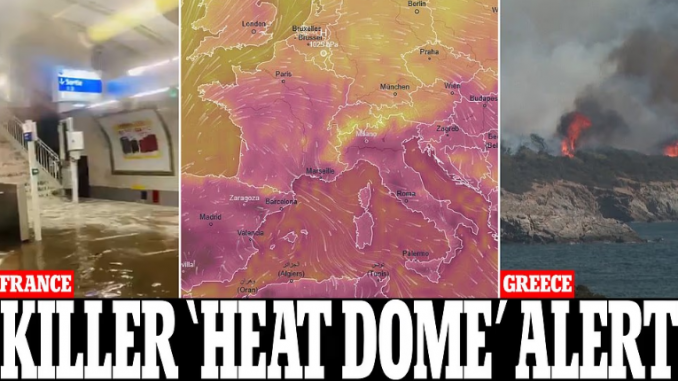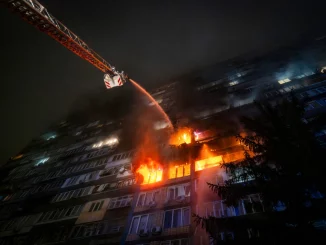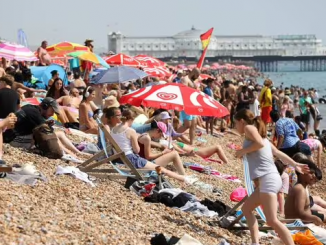
Temperatures in Spain could reach a hellish 47C this weekend, while sweltering infernos in Italy have led to roads melting as raging wildfires continue to tear through Greece. A tourist died from heatstroke on the Spanish island of Mallorca on Thursday as a baking heatwave from Africa neared the Iberian Peninsula, with temperatures set to soar dramatically over the coming days. Meteorologist Gernot Schutz expects record-breaking temperatures to peak between Saturday and next Wednesday, saying that ‘during this period, temperatures in the south could rise to 45 degrees Celsius, and in some places reach 46 or 47 degrees Celsisus.’
| Published June 27, 2025
These are seasonal challenges, not signs of a larger crisis—just the kind of extreme summer weather Europe has faced before and will face again.
Southern Europe is currently experiencing intense summer heat, wildfires, and storms—conditions quickly labeled as evidence of “climate change” by media outlets and climate advocates. But not everyone is buying into the hype. Seasoned meteorologists and observers argue that while the weather is extreme, it’s not without precedent—and that selective reporting ignores equally significant cold events across the globe.
🌡️ Scorching but Not Shocking
Spain saw 47°C (116.6°F) in Córdoba and Seville, leading headlines—but longtime residents recall similar temperatures decades ago. Italy, France, and Germany followed with highs between 35°C and 40°C. Rome issued red alerts, and power grids were strained. Still, heatwaves have occurred well before carbon rhetoric took over the climate conversation.
Even CNN’s own meteorologist Chad Myers pushed back against the climate narrative, saying:
“Just because it’s hot in one part of the world doesn’t mean it’s climate change… That’s not how it works.”
Myers, a meteorologist for decades, warned against media sensationalism, emphasizing that heatwaves have always been part of seasonal patterns.
🔥 Wildfires and Weather Extremes
Over 100 wildfires burned across Sicily and Calabria, driven by dry brush, wind, and human activity—not CO₂ levels. Greece faced evacuations from blazes near Athens and Rhodes, worsened by lightning storms. While alarming, these patterns aren’t new. Mediterranean summers are notorious for fire outbreaks, long before global warming narratives.
France and Spain declared “extreme danger” fire zones. But as always, local conditions—neglect, arson, poor forest management—play a greater role than climate models admit.
⛔ Infrastructure Strains, Not Systemic Collapse
France’s nuclear plants reduced output due to warmer river water, but this has happened before. Germany warned of power shortages from AC demand—a modern issue, not an environmental catastrophe.
Meanwhile, urban heat islands, with cement-heavy design and sparse greenery, naturally hold more heat. That’s a design flaw, not proof of runaway climate change.
🧊 Cold Records Ignored by Climate Media
While Europe bakes, South America freezes—and most news outlets ignore it. In Brazil’s São Paulo, temperatures dipped below freezing. Chile’s Atacama Desert, one of the driest places on Earth, saw rare snowfall. Hungary’s cherry harvest was devastated by an unusually late frost.
Electroverse points out that these cold events counterbalance the warming narrative. Despite dramatic headlines, the global temperature metric has become increasingly meaningless, cherry-picking hot events and disregarding cold anomalies.
🤔 Keep a Cool Head: Weather Is Not a Crisis
Yes, Europe is hot. But it’s been hot before. Media coverage focuses only on extremes that support a single narrative, ignoring natural variability, history, and regional differences.
It’s time to differentiate between actual emergencies and ordinary weather patterns exaggerated for attention. Instead of pushing panic, we should focus on better urban planning, smarter energy use, and honest data reporting.

A killer heatwave has descended on Europe, with record breaking temperatures set to hit Spain over the coming days

GREECE: Hundreds of firefighters in Greece also battled a wildfire which burned out of control on the eastern Aegean island of Chios this week. Pictured: A wildfire burns trees by the sea in Lithi, Chios island, Greece, 24 June

SPAIN: A tourist died from heatstroke on the Spanish island of Mallorca on Thursday as a baking heatwave from Africa neared the Iberian Peninsula. Pictured: A man cools himself down in a water fountain in central Madrid
💸 Trillions Spent, But Are Climate Claims Built on Faulty Data?
A growing number of scientists and analysts are questioning the accuracy of the data driving global climate policies—especially as world governments spend trillions on carbon-reduction plans. According to a report covered by The Epoch Times, the very temperature readings and climate models that fuel these initiatives are deeply flawed.
🌡️ Data Gaps, Urban Biases, and “Adjusted” Readings
The report points out a disturbing trend: many temperature stations used to measure “global warming” are located near urban zones, airports, or heat-reflecting surfaces like asphalt—falsely inflating recorded temperatures. These “urban heat island” effects are often mistaken for global climate shifts.
Worse, in many cases where accurate data is missing, temperatures are “adjusted” by climate modelers, introducing human bias and speculation. This means policy decisions are often based not on actual measurements—but on computer-generated estimates.
🧮 Models That Fail to Predict Reality
Climate models are another target of scrutiny. Despite years of dire forecasts, many model predictions have missed the mark—overestimating warming trends and underestimating natural climate variability.
These flawed models have still been used as the foundation for sweeping government policies, regulations, and trillions in spending commitments.
🔍 No Consensus, No Transparency
Contrary to the “settled science” narrative, the article highlights how many experts disagree with the mainstream view—but are often excluded from public discussions. There is no real scientific consensus, and yet politicians continue to push carbon taxes, bans on gas-powered vehicles, and forced energy transitions.
🚨 The Real Emergency: Misguided Spending?
With global inflation, energy crises, and rising national debts, critics say we should take a harder look at where climate funding is going—and whether it’s justified. Taxpayers deserve transparency when trillions are being spent based on data that may not hold up to scrutiny.
🔍 Implications of Persistent Heat and “Heat Domes” in Europe
🔥 Europe’s Heatwave: Real-World Challenges, Not Climate Panic
Europe is dealing with another intense summer, marked by high temperatures and so-called “heat domes.” While headlines scream climate catastrophe, seasoned observers point to familiar seasonal patterns. The impacts are tangible—but they’re also manageable and expected, not signs of global collapse.
🏥 Health Strains Are Seasonal, Not Unprecedented
Hospitals are treating more people for heat exhaustion and dehydration, especially among the elderly. But this isn’t new. Similar surges occur in many hot summers, and public health systems already have protocols in place. It’s not climate change—it’s summer preparedness.
🔥 Fires Follow Familiar Patterns
Italy, Spain, and Greece are once again battling seasonal wildfires—driven by dry brush, human activity, and hot winds. It happens nearly every July and August. Firefighters train for this every year, and while the danger is real, it’s not unusual or unpredictable.
⚡ Energy Demand: A Modern Lifestyle Issue
Yes, power grids are under pressure from air conditioning spikes, especially in Germany and France. But that’s not evidence of a climate crisis—it’s a sign of growing energy use in modern homes. Demand management and smarter energy policy—not fear—are the solutions.
🚱 Water and Agriculture: Common Dry-Season Stress
Dry conditions are affecting crops and requiring more irrigation. But again, this happens nearly every dry season. Farmers adapt, reservoirs are monitored, and water policies are designed for fluctuations. Calling it a crisis every time it gets hot is misleading.
🏙️ Urban Heat: A Design Problem, Not a Climate Emergency
Cities naturally trap more heat due to buildings and concrete—a long-known issue. The answer isn’t panic over emissions, but more trees, shaded areas, and smart urban planning. Simple, local solutions beat sweeping global theories.
🤔 Keep the Focus Local and Practical
Europe’s summer heat is challenging—but not unprecedented. The real solutions lie in preparedness, infrastructure, and common sense—not in funneling billions into unreliable models or speculative climate fears.

FRANCE: Violent storms in France saw Paris’ metro system flood. Screen grab shows a flooded Metro station in the French capital following a torrential downpour on Thursday night

FRANCE: Footage on social media showed the flooded streets of Paris on Thursday evening following a deadly thunderstorm that killed two people

GERMANY: A woman shields herself with an umbrella on Alexanderplatz square in Berlin amid a storm on Thursday

GREECE: 9 A wildfire front as seen from the port of Lithi in Chios, Greece, 24 June

SPAIN: People sit next to a large outdoor fan to keep cool at a restaurant terrace during high temperatures in Madrid on Friday

Large parts of western and southern Europe will experience a heatwave this weekend
“hottest weather in 120,000 years” – by Tony Heller
Have you seen Tony Heller’s video about that claim—“this is the hottest weather in 120,000 years”? He completely breaks it down.
He starts by calling out how ridiculous that headline is. The media keeps repeating it, but when you look closer, it’s based on questionable data—specifically that infamous “hockey stick” graph by Michael Mann. You know the one—flat temperatures for thousands of years, then suddenly a spike in the 20th century. Heller shows how that graph is built on reconstructed data that ignores past warm periods, especially the Eemian interglacial, which was actually hotter than today—and happened long before industrial CO₂.
He also points out that during the Eemian, CO₂ levels were much lower—around 275 ppm—but global temperatures were higher. So how can they say CO₂ is the main driver of temperature? That’s a serious hole in the narrative.
Then Heller digs into how today’s climate models rarely account for natural influences like changes in the Earth’s orbit, ocean cycles, or solar activity. These are massive forces that shaped Earth’s climate long before anyone burned a drop of oil.
Bottom line? Heller’s video supports what we’ve been saying: this heatwave isn’t unprecedented, the data being used to justify trillions in climate spending is flawed, and the science isn’t settled—no matter how loudly the media insists otherwise.
💬 Overall Takeaway: Weather Is Local—Solutions Should Be Too
Across Europe, the media is calling this summer the “hottest in 120,000 years,” blaming every heatwave, wildfire, and power surge on so-called man-made climate change. But when we step back, a different picture emerges—one grounded in history, science, and plain common sense.
As Tony Heller and other critics have shown, the climate narrative pushed by mainstream outlets is often built on adjusted temperature data, flawed computer models, and cherry-picked headlines. They ignore colder records elsewhere in the world, exaggerate heat in urban areas, and downplay the natural climate cycles that have shaped Earth for millennia.
Yes, summer heat can be dangerous. Fires need to be managed. Cities need better planning. But that doesn’t mean the climate is collapsing or that we need to spend trillions chasing unreliable models. The real crisis isn’t in the weather—it’s in how we’re being told to think about it.
It’s time to stop panicking, start thinking critically, and focus on practical, local solutions—not political agendas dressed up as science.





Be the first to comment